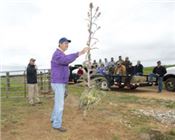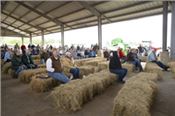|
AgCenter Field Day Features Pasture, Cattle Information
HOMER, LA.
Cattle producers should not be overeager to plant multiple forage crops in their pastures, particularly if they do not have a specific purpose in mind, an LSU AgCenter scientist said at a recent field day.
“We don’t need to plant a lot of different things if we don’t know why or if we don’t know the benefit,” Buddy Pitman, a forage specialist, said April 26 at the AgCenter Hill Farm Research Station in Homer.
In addition to being food for cattle, forage crops such as clovers and other legumes offer potential soil health benefits, including improved fertility and infiltration. But they cost money and can compete with grasses already in pastures, Pitman said.
Planting a variety of forages in hopes of generally bettering the soil can be tempting. It is better, however, to have a soil test performed to determine any nutrient deficiencies, then address those problems, Pitman said.
Extra forage crops may prove unnecessary, he said, especially in pastures where the producer will apply fertilizer anyway or if the producer is not trying to reach specific soil health goals.
Those who want to try different forages may be able to enroll in Natural Resources Conservation Service incentive programs, said AgCenter economist Naveen Adusumilli.
It is important to find the proper balance between chemical- and plant-based fertilization, said AgCenter forage specialist Wink Alison.
He is part of a group of AgCenter scientists studying how grasses, brassicas and legumes each affect soil health when planted into existing bermudagrass pastures – a process known as overseeding.
Cattle producers commonly overseed pastures with ryegrass. The scientists are trying to find out what advantages other plants – such as brassica crops, which have a different root structure – may provide.
Improving the fertility and other aspects of soil also may help keep some pasture weeds at bay, said AgCenter weed scientist Ron Strahan. For example, smutgrass, which Strahan said is moving northward in Louisiana, typically shows up in pastures where the soil is compacted and overgrazed.
He reviewed herbicides and other ways to control several weeds at the field day.
Other speakers at the event included:
• Dr. Clare Scully, of the LSU School of Veterinary Medicine, who gave tips on dealing with calving difficulties.
• AgCenter livestock specialist Tim Page, who talked about bull selection and tools such as expected progeny differences (EPDs) that can help producers choose animals best suited to their operations.
• Economist Derrell Peel, of Oklahoma State University, who said beef prices and demand remain good. “We’ve been in expansion mode. We’re not done with it yet,” he said.
• Louisiana Master Farmer Program director Ronnie Levy, who gave information on the program.
• AgCenter associate vice president Rogers Leonard, who announced he is now in charge of most AgCenter animal programs in addition to his responsibilities leading plant, soil and water efforts. ∆

LSU AgCenter weed scientist Ron Strahan, left, talks about how to control pasture weeds,
such as this extremely large thistle held by Chuck Griffin, AgCenter agent in DeSoto
Parish, during the sixth annual Northwest Beef and Forage Field Day at the Hill Farm
Research Station in Homer on April 26, 2018.
Photos by Olivia McClure/LSU AgCenter

Attendees listen to presentations during the sixth annual Northwest Beef and Forage Field Day
at the LSU AgCenter Hill Farm Research Station in Homer on April 26, 2018.
Photos by Olivia McClure/LSU AgCenter
|
|